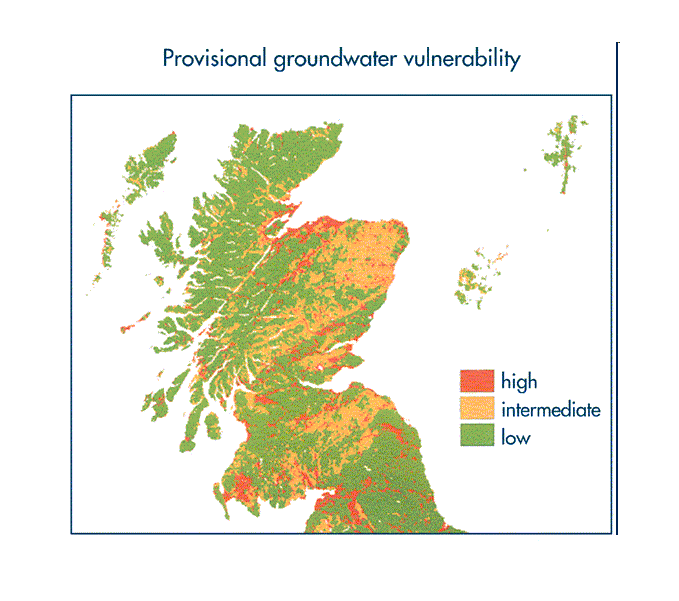 This page has been mothballed.
This page has been mothballed.
It is no longer being updated but we've left it here for reference.
Foot and Mouth Research
Research on Groundwater vulnerability
Two issues arise post FMD regarding ground water and diffuse pollution: firstly there is the obvious problem of managing the large quantities of pollutants that may leak out from the massive carcass burial sites and secondly there are the opportunities on restocking, to improve certain aspects of farm activity to minimise diffuse pollution in the future.

In choosing the carcass disposal sites in Scotland, the Scottish Environmental Protection Agency have used maps of soil leaching risk, produced here in the Macaulay Land Use Research Institute.
"Although there are obvious requirements for appropriate monitoring and evaluation of the impact of carcass disposal on groundwaters, perhaps we also have a tremendous opportunity to consider the future interaction of agriculture on water quality at a time when so many day to day activities have been suspended.
For example, it is clear that the biggest threat to water quality in future is from diffuse sources. These are sources that are distributed throughout the landscape a consequence of mans activities and which are usually very difficult to pinpoint and control. However, we do know that yard activities, livestock feeding and watering areas have historically been problem sites where issues such as high stocking density and soil damage have resulted in the transport of sediment, bacteria, and nutrients to streams and rivers. Similarly, Salmonella, E.coli and other pathogens such as Cryptosporidium can be transmitted through water, and any practices that encourage the separation of livestock and their faecal material from watercourses are highly desirable.
Now, while farms are without stock, would provide the perfect opportunity to consider how we might address these problem issues. The construction of well positioned and suitable access tracks for animal movement, the development of purpose built collection and retention areas for yard runoff, and the establishment of buffer strips around stream corridors should all now be given higher priority.
An appropriate environmental grant system would encourage the adoption of such best management practices, and would provide an excellent demonstration for the rest of the farming community. This could provide a unique catalyst for the expansion of such schemes throughout Scotland. This would not only enhance water quality and habitat quality for generations to come, but would place us as a key leader in land and water management in Europe." - Bob Ferrier, Macaulay Land Use Research Institute (Programme Manager for "Integrated Catchment Management").
Research at Macaulay has led to the development of groundwater vulnerability maps like the one below. This is a result of combining a number of different spatial data sets within a model of soil leaching and hydrology. Components of the research are described by this paper (![]() ) , as well as at the "HOST" website. Detailed and relevant information about the groundwater vulnerability in foot and mouth regions could be provided with minor modifications to existing predictive models used at the Macaulay Land Use Research Institute.
) , as well as at the "HOST" website. Detailed and relevant information about the groundwater vulnerability in foot and mouth regions could be provided with minor modifications to existing predictive models used at the Macaulay Land Use Research Institute.

